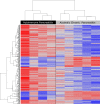Autoantibodies against the exocrine pancreas in autoimmune pancreatitis: gene and protein expression profiling and immunoassays identify pancreatic enzymes as a major target of the inflammatory process
- PMID: 20407433
- PMCID: PMC3099227
- DOI: 10.1038/ajg.2010.141
Autoantibodies against the exocrine pancreas in autoimmune pancreatitis: gene and protein expression profiling and immunoassays identify pancreatic enzymes as a major target of the inflammatory process
Erratum in
- Am J Gastroenterol. 2011 Dec;106(12):2209. Jesnowski, Ralf [corrected to Jesenofsky, Ralf]
Abstract
Objectives: Autoimmune pancreatitis (AIP) is thought to be an immune-mediated inflammatory process, directed against the epithelial components of the pancreas. The objective was to identify novel markers of disease and to unravel the pathogenesis of AIP.
Methods: To explore key targets of the inflammatory process, we analyzed the expression of proteins at the RNA and protein level using genomics and proteomics, immunohistochemistry, western blot, and immunoassay. An animal model of AIP with LP-BM5 murine leukemia virus-infected mice was studied in parallel. RNA microarrays of pancreatic tissue from 12 patients with AIP were compared with those of 8 patients with non-AIP chronic pancreatitis.
Results: Expression profiling showed 272 upregulated genes, including those encoding for immunoglobulins, chemokines and their receptors, and 86 downregulated genes, including those for pancreatic proteases such as three trypsinogen isoforms. Protein profiling showed that the expression of trypsinogens and other pancreatic enzymes was greatly reduced. Immunohistochemistry showed a near-loss of trypsin-positive acinar cells, which was also confirmed by western blotting. The serum of AIP patients contained high titers of autoantibodies against the trypsinogens PRSS1 and PRSS2 but not against PRSS3. In addition, there were autoantibodies against the trypsin inhibitor PSTI (the product of the SPINK1 gene). In the pancreas of AIP animals, we found similar protein patterns and a reduction in trypsinogen.
Conclusions: These data indicate that the immune-mediated process characterizing AIP involves pancreatic acinar cells and their secretory enzymes such as trypsin isoforms. Demonstration of trypsinogen autoantibodies may be helpful for the diagnosis of AIP.
Figures










References
-
- Finkelberg DL, Sahani D, Deshpande V, et al. Autoimmune pancreatitis. N Engl J Med. 2006;355:2670–6. - PubMed
-
- Pickartz T, Mayerle J, Lerch MM. Autoimmune pancreatitis. Nat Clin Pract Gastroenterol Hepatol. 2007;4:314–23. - PubMed
-
- Gardner TB, Levy MJ, Takahashi N, et al. Misdiagnosis of autoimmune pancreatitis: a caution to clinicians. Am J Gastroenterol. 2009;104:1620–3. - PubMed
-
- Yoshida K, Toki F, Takeuchi T, et al. Chronic pancreatitis caused by an autoimmune abnormality. Proposal of the concept of autoimmune pancreatitis. Dig Dis Sci. 1995;40:1561–1568. - PubMed
-
- Zamboni G, Luttges J, Capelli P, et al. Histopathological features of diagnostic and clinical relevance in autoimmune pancreatitis: a study on 53 resection specimens and 9 biopsy specimens. Virchows Arch. 2004;445:552–63. - PubMed
Publication types
MeSH terms
Substances
Grants and funding
LinkOut - more resources
Full Text Sources
Other Literature Sources
Medical
Molecular Biology Databases
Miscellaneous

